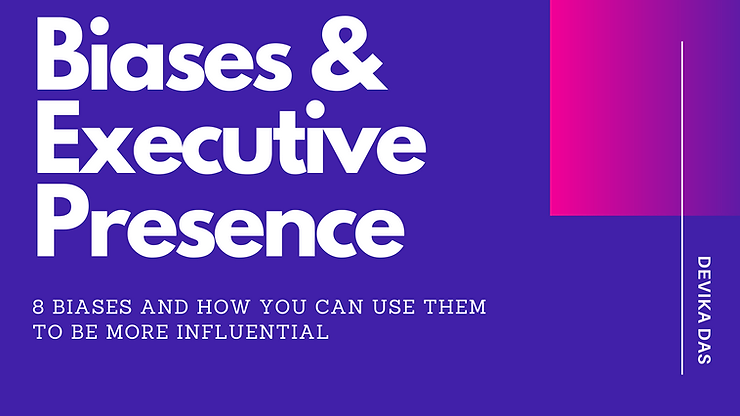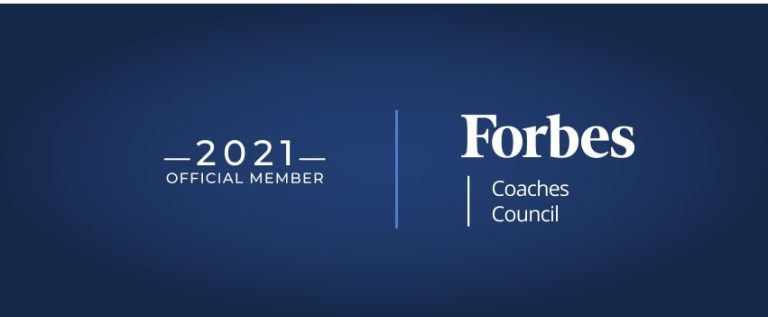
Executive Presence & Biases: 8 Biases and how you can use them to be more influential

What is Executive Presence?
As a coach specializing in the psychoanalytical perspective of executive presence- my definition is of executive presence is deeper than just communication skills and power posing(not a fan of Amy Cuddy!) For now (until I can write on the topic in detail), the article below is written with this definition of executive presence in mind.
Executive presence is the ability to see oneself as a leader and be seen as a leader. This includes having power, authority, influence to be of impact at the workplace.
What is Bias?
A Bias is a general pattern or tendency to think a certain way. It is essentially a quick route our brains can use in order to make decisions quickly. Biases can be practical and common (such as avoiding a dangerously shaky bridge) but sometimes negative biases can develop as well.
Why are they related?
Human beings are not as rational as we think. If it were so, let’s face it, science would not be having such a tough time these days. There are many nuances of what impacts perception. A lot of responsibility for having an executive presence is on the person who is observed and not the observer. All of us have biases and most of us are not aware of them. Without a doubt, few people in power have the humility to be self-aware.
To understand the shortcut the brain is making in your stakeholders’ mind. You can use it to make an impact and get buy-in. Learning to read others is a superpower- here is a glimpse of what biases are and how to use them to your advantage.
1. Anchoring Bias
Anchoring or focalism is a cognitive bias where an individual depends too heavily on an initial piece of information offered to make subsequent judgments during decision making. Once the value of this anchor is set, all future negotiations, arguments, estimates, etc. are discussed in relation to the anchor.
Executive Presence Tip:
Lead with your core strength. Make a great first impression. Especially women should establish competence early.
2. Availability Bias
The availability heuristic, also known as availability bias, is a mental shortcut that relies on immediate examples that come to a given person’s mind when evaluating a specific topic, concept, method, or decision and in case of someone else’s presence.
Executive Presence Tip:
Use stories and testimonials as examples for others to have a feel of how you will impact their work lives positively. Let others be aware of your memorable successes.
3. Bandwagon Bias
Bandwagon bias is a form of groupthink. It’s a cognitive bias that makes us believe something because other people believe it. It can make us think something that is achievable is impossible because others have tried and failed before us. A person is more likely to go along with a belief if there are many others who hold that belief. Other names for this are “herd mentality” or “group think”.
Executive Presence Tip:
Find the key people in the group reach out to them. Once they include you the rest of the group will believe you are a part of them too. When accepted in remember to hear minority opinions. Don’t forget how it feels to be excluded.
4. Ostrich Effect:
In behavioral finance, the ostrich effect is the attempt made by investors to avoid negative financial information. The name comes from the common legend that ostriches bury their heads in the sand to avoid danger. Avoiding bad news about a decision by ignoring data that might be negative. People avoid information in various ways the most common is to avoid discomforting bad news.
Executive presence tip:
Focus on the positive silver lining, the solution, rally your troups, be the soft place to fall on. Caveat: Don’t be an escapist. People will recognize cowardise.
5. Recency Effect
The Serial-position effect is the tendency of a person to recall the first and last items in a series best, and the middle items worst. Recent events are easier to remember and can be weighed more heavily than past events or potential future events.
Executive Presence Tip:
Wait for your turn. Stay in the shadows untill the time is right. To Stay in a stake holders mind. Increase connection or visibility when decisions are made that impact you.
6. Halo Effect
Halo effect is the tendency for positive impressions of a person, company, brand, or product in one area to positively influence one’s opinion or feelings in other areas. It is a type of cognitive bias and is the opposite of the horn effect. Judging others similarly on all traits, assuming that because someone is good or bad at one thing they will be equally good or bad at another.
Executive Presence Tip:
Use a single reference point as a means for people to form an opinion. This could be education, previous role, title, physical appearance. There is a chance that (depending on the projections of the stakeholer) they would form and opinion from this single trait- the rest will follow.
7. Ingroup Preference Bias:
In-group favoritism, sometimes known as in-group–out-group bias, in-group bias, intergroup bias, or in-group preference, is a pattern of favoring members of one’s in-group over out-group members. This can be expressed in the evaluation of others, in the allocation of resources, and in many other ways.
People tend to divide themselves into groups, and then attribute positive attributes to their own group. Search committee members who perceive commonalities with applicants are more likely to view them favorably
Executive Presence Tip:
Look for commonalities and stay relatable- connection on small aspects of life as well as a few bigger ones. Don’t be a sychophant. Make sure you also have a few differentiating points to be the object of interest.
8. The “Jerk” Factor
It’s not a cognitive bias, but research has shown an academic tendency to over-value individuals who display “brilliant but cruel” behavior and to attribute less intelligence to people with “nice” behavior.
Executive Presence Tip:
Don’t try to please too much. It is all right to draw steel boundaries or push back. There is no need to pollyanish- There are a few people who would call Steve Jobs a jerk then there are a lot who would also say he had a fantastic presence. Let the dark side show once in a while.
What’s the next step in your career?
Let's Work TogetherI’ll help you find the answer and make it happen.
Book a call

